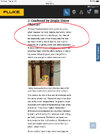JimGnitecki
Member
- Joined
- Mar 28, 2010
- Messages
- 1,258
I have a Lyman Mag 25 furnace with its own built-in temperature measuring and control system. But my s.s. alloying pot - a saucepan conscripted into this service - of course has no built-in thermometer. In my TIG welding, I use a digital infrared thermometer gun to check material temperature. It captures the temperature of an item by simply aiming at the item and pulling the trigger. So, I am wondering: if I aim the gun at a pot of molten Lead, will I get a usable reading? Or do I need to buy a "Lead casting thermometer"?
Jim G
Jim G



